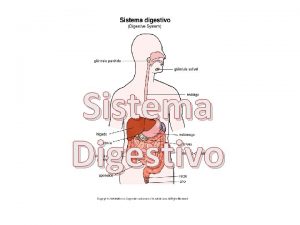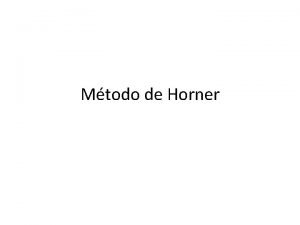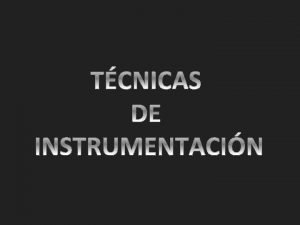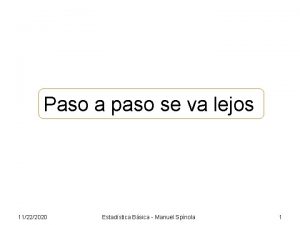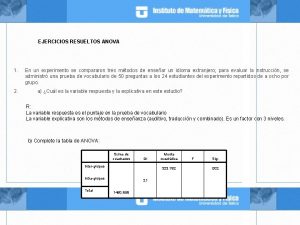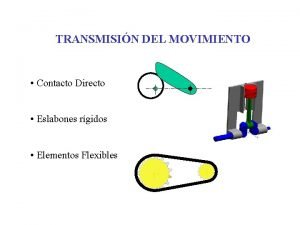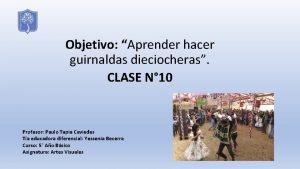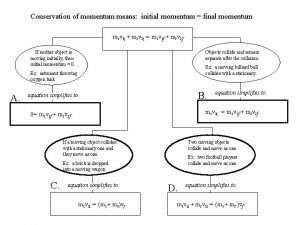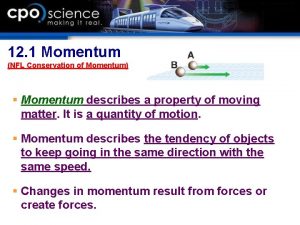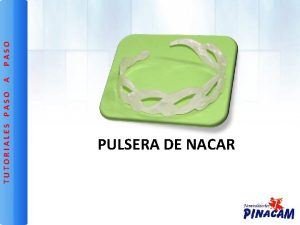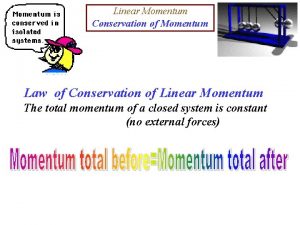Conservation of Momentum El Paso Independent School District












- Slides: 12

Conservation of Momentum El Paso Independent School District

A Collision of Two Masses When two masses m 1 and m 2 collide, we will use the symbol vo to describe velocities before collision. Before m 1 vo 2 The symbol vf will describe velocities after collision. vf 1 After m 1 m 2 vf 2 m 2

A Collision of Two Blocks Before m 1 vo 2 m 2 Collision “vo”= Before After vf 1 m 1 “vf” = After m 2 B m 2 vf 2

Conservation of Momentum The total momentum AFTER a collision is equal to the total momentum BEFORE. m. Avf. A + m. Bvf. B = m. Avo. A + m. Bvo. B A v. B B B v. A A B v. B

Example: A 2 -kg block A and a 1 -kg block B are pushed together against a spring and tied with a cord. When the cord breaks, the 1 -kg block moves to the right at 8 m/s. What is the velocity of the 2 kg block? A B The initial velocities are zero, so that the total momentum before release is zero. 0 0

Elastic or Inelastic? An elastic collision loses no In an inelastic collision, energy and the objects energy is lost and the rebound off each other. All objects stick together. energy is transferred from one object to the other.

Completely Inelastic Collisions where two objects stick together and have a common velocity after impact. Before After

Example: A 60 -kg football player stands on a frictionless lake of ice. He catches a 2 -kg football and then moves at 0. 4 m/s. What was the initial velocity of the football? A B Given: vo. B= 0; m. A= 2 kg; m. B= 60 kg; vf. B= vf. A = 0. 4 m/s 0 m. Avf. A + m. Bvf. B = m. Avo. A + m. Bvo. B (m. A + m. B)vf = m. Avo. A (2 kg + 60 kg)(0. 4 m/s) = (2 kg) vo. A = 12. 4 m/s

Example: An 87 -kg skater B collides with a 22 -kg skater A initially at rest on ice. They move together after the collision at 2. 4 m/s. Find the velocity of the skater B before the collision. Common speed after colliding: 2. 4 m/s. vo. A = 0 vo. B = ? 87 kg A 22 kg vf. B= vf. A = vf = 2. 4 m/s m. Avo. A +m. Bvo. B = (m. A + m. B)vf B (87 kg)vo. B = (87 kg + 22 kg)(2. 4 m/s) (87 kg) vo. B =262 kg m/s vo. B = 3. 01 m/s

Example: A 50 g bullet strikes a 1 -kg block, passes all the way through, then lodges into the 2 kg block. Afterward, the 1 kg block moves at 1 m/s and the 2 kg block moves at 2 m/s. What was the entrance velocity of the bullet? vo. A= ? 2 kg 1 m/s 1 kg 2 m/s

Find entrance velocity of bullet: m. A= 0. 05 kg; vo. A= ? A 50 g B 1 kg 1 m/s Momentum After = Momentum Before 0 C 2 kg 1 kg 0 2 kg m. Avo. A + m. Bvo. B + m. Cvo. C = m. Bvf. B + (m. A+m. C) vf. AC (0. 05 kg) vo. A=(1 kg)(1 m/s)+(2. 05 kg)(2 m/s) (0. 05 kg) vo. A =(5. 1 kg m/s) vo. A= 102 m/s

Example: A 0. 150 kg bullet is fired at 715 m/s into a 2 -kg wooden block at rest. The velocity of block afterward is 40 m/s. The bullet passes through the block and emerges with what velocity? mavoa + mbvob = mavfa + mbvfb A v o. B = 0 (0. 150 kg)v. A+ (2 kg)(40 m/s) = (0. 150 kg)(715 m/s) 0. 150 v. A+ (80 m/s) = (107 m/s) 0. 150 v. A = 27. 2 m/s v. A = 181 m/s B
 Que es la degradacion en el sistema digestivo
Que es la degradacion en el sistema digestivo Relevamiento de activos y pasivos externos afip paso a paso
Relevamiento de activos y pasivos externos afip paso a paso Como realizar un marco teorico paso a paso
Como realizar un marco teorico paso a paso Proceso de arranque del computador
Proceso de arranque del computador Metodo horner
Metodo horner Libro iva digital paso a paso
Libro iva digital paso a paso Tecnica step back y crown down
Tecnica step back y crown down El afiche
El afiche Cifrado por bloques
Cifrado por bloques Paso a paso se va lejos
Paso a paso se va lejos Ejercicios resueltos anova
Ejercicios resueltos anova Paso a paso
Paso a paso Como hacer guirnaldas dieciocheras
Como hacer guirnaldas dieciocheras
